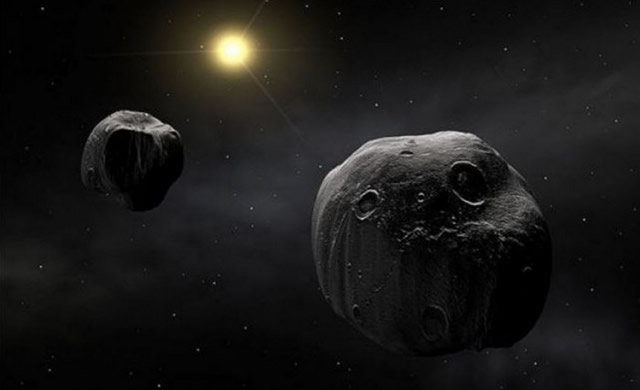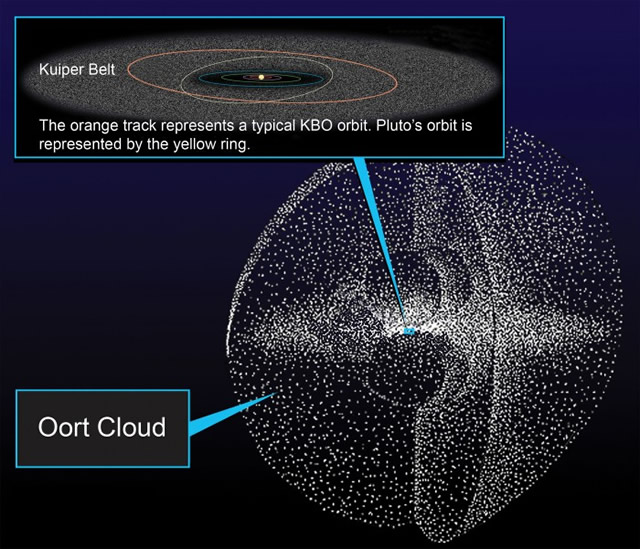
2010 WG9 – Credit: ESO
Sappiamo che il Sistema Solare è un posto molto esotico e pieno di posti strani, ma se da una parte stiamo iniziando a farci un’idea di cosa possiamo trovare tra i vari pianeti, lune, asteroidi e comete, c’è una regione che è completamente al di là della nostra portata per adesso: la Nube di Oort.
Si pensa sia una grande nube sferica che circonda la zona più remota del Sistema Solare, quasi a metà via tra noi e la più vicina stella, rimasta dopo la fine della formazione del Sistema Solare. Ma di cosa sia composta o quanto esattamente è grande, è ancora un mistero. L’idea principale però è che sia la casa delle comete che vediamo sempre arrivare dalle nostre parti, apparentemente da tutte le direzioni. Immaginate quante cose si potrebbero scoprire se mandassimo una sonda da quelle parti! Purtroppo però, si trova in una regione che spazia da 1 a 2 anni luce da noi. Quindi chissà quando o se riusciremmo mai a raggiungerla. Ma non è ancora tutto perduto. Se Maometto non va dalla Nube di Oort, allora magari può venire la Nube di Oort da Maometto. In questo caso stiamo parlando di un misterioso oggetto di nome 2010 WG9, che si trova oltre l’orbita di Nettuno, e si pensa sia un oggetto originario della Nube di Oort che è stato spinto fuori dalla sua orbita ed è diretto dalle nostre parti, permettendoci di vederlo in maniera molto dettagliata.
Fonte/Leggi tutto → www.link2universe.net

What if we could journey to the outer edge of the Solar System – beyond the familiar rocky planets and the gas giants, past the orbits of asteroids and comets – one thousand times further still – to the spherical shell of icy particles that enshrouds the Solar System.
This shell, more commonly known as the Oort cloud, is believed to be a remnant of the early Solar System. Imagine what astronomers could learn about the early Solar System by sending a probe to the Oort cloud! Unfortunately 1-2 light years is more than a little beyond our reach. But we’re not entirely out of luck. 2010 WG9 – a trans-Neptunian object — is actually an Oort Cloud object in disguise. It has been kicked out of its orbit, and is heading closer towards us so we can get an unprecedented look.
But it gets even better! 2010 WG9 won’t get close to the Sun, meaning that its icy surface will remain well-preserved. Dr. David Rabinowitz, lead author of a paper about the ongoing observations of this object told Universe Today, “This is one of the Holy Grails of Planetary Science – to observe an unaltered planetesimal left over from the time of Solar System formation.” Now you might be thinking: wait, don’t comets come from the Oort Cloud? It’s true; most comets were pulled out of the Oort cloud by a gravitational disturbance. But observing comets is extremely difficult, as they are surrounded by bright clouds of dust and gas. They also come much closer to the Sun, meaning that their ices evaporate and their original surface is not preserved. So while there is a surprisingly high number of Oort cloud objects hanging out within the inner solar system, we needed to find one that is easy to observe and whose surface is well preserved. 2010 WG9 is just the object for the job! It is not covered by dust or gas, and is believed to have spent most of its lifetime at distances greater than 1000 AU. In fact, it will never approach closer than Uranus.
Source/Continue reading → www.universetoday.com





















